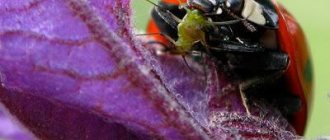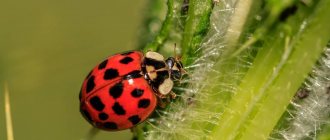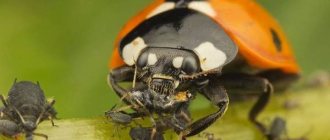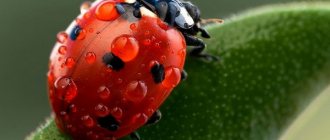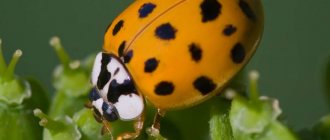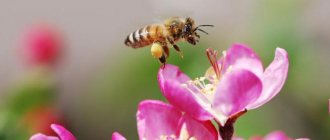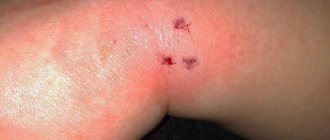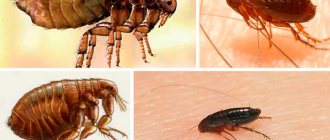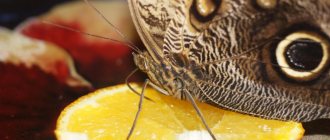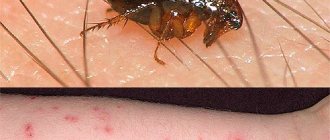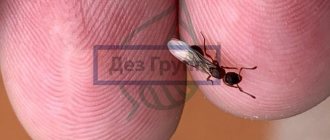Can this insect bite or not?
Of the large number of varieties of ladybugs, and there are more than 5,200 species, only a couple of species bite and are dangerous to humans, for example, Harlequin and with 28 spots. They can bite hard and cause harm to the body.
Other species only pinch prey with their claws in case of attack or defense. The ladybug secretes a special yellow secretion from the joints of its legs, which is poison for most insects. It smells sharp, tastes bitter, and can scare off the main enemies:
- frog;
- insects that feed on cows;
- spiders
Birds also try to avoid it because of its unpleasant taste.
Important! The ladybug belongs to the class of predators, because it feeds not only on herbaceous food, leaves, but also on other insects such as slugs, snails, aphids, spider mites, and its relatives.
The onset of winter forces the insect to prepare for hibernation. The cow stores nutrients and removes excess water from its body. At this time, from the end of September, it becomes as aggressive as possible and can even attack a person.
Natural enemies
Bright coloring, bitter taste, and the ability to secrete poisonous hemolymph with an unpleasant odor provide small bugs with protection from many natural enemies. Birds, large insect predators, insectivores, and spiders do not eat ladybugs.
The only creatures that pose a danger to coccinellids are the ichneumon fly Dinocampus. It lays eggs in the body of larvae and adults, and then the hatched larvae eat the body of the victim, which leads to its death. Dinocampus find beetles by the very smell that repels all other enemies.
How dangerous is the bite, is it poisonous to humans?
While playing with a ladybug in your palm, pay attention to its color.
An ordinary red little cow with 7 spots is not dangerous to humans. But with 28 spots or black with red dots, a Harlequin can bite quite painfully and with consequences.
An ordinary cow, pinching a person and releasing its juice, can provoke a slight tingling of the skin, which is not dangerous for most.
But after being bitten by a 28-spotted one, you will have to seek help from a medical facility. The ladybug does not feed on human blood, so it cannot become a carrier of diseases for him, like a mosquito.
The big danger lies in the secretion released from the joints. This is the hemolymph of an insect, containing two alkaloids:
- adalen;
- coccinellin.
The poisonous hemolymph also contains the poison cantharidin. When this poison comes into contact with human skin, the hair follicle is affected, resulting in large blisters and swelling.
If you accidentally eat a poisonous ladybug, then cantharidin entering the digestive tract can cause a person to:
- nausea;
- dizziness;
- severe poisoning;
- intoxication.
The 7-spotted red beetle is not dangerous if, for example, it is accidentally swallowed by a child or gets into food. Her lymph contains cantharidin in small quantities, not enough to cause poisoning.
Gardeners note that during the grape harvest, a large number of bugs getting into the wine can change its taste.
What types of ladybugs bite?
The ladybug family includes more than 4,000 different species, the most common of which is the seven-spotted ladybug. This member of the family is considered harmless to humans and brings great benefits, as it destroys a dangerous garden pest - aphids.
The most aggressive “bugs” that can bite through human skin are considered to be two species.
Description and photo of the most dangerous black species of Harlequin
Let's look at what makes the black Harlequin cow special and dangerous. Another name for the breed is the Asian ladybug. Because of their gluttony, the first insects were brought to the countries of America and Europe from Asia to control pests in greenhouses, since the Harlequin eats up to 200 aphids per day.
But scientists were unable to control the insects. This species is rapidly multiplying throughout the planet, adapting at the expense of local cows and destroying its relatives.
She loves shady places with a lot of greenery, trees, and bushes. The body of the Asian Harlequin can be attacked by parasites and mites. Therefore, this species is a carrier of diseases and poses a threat to other insects and people.
Harlequin causes irreparable harm to a person. Settling in a summer cottage or garden, the insect eats the foliage of radishes, beets, cabbage, potatoes, and garden trees. An invasion of ladybugs can completely destroy a crop in a few days.
The bite of the Harlequin ladybug resembles a mosquito bite, only it releases yellow poison and causes a severe allergic reaction on the skin. People prone to allergies may experience anaphylactic shock.
You can distinguish it from a mosquito by several characteristics:
- the poison irritates the skin, the bite site turns red;
- there is a strong feeling of itching;
- the skin becomes swollen and swells;
- an allergic reaction occurs.
To avoid being bitten, it is not recommended to handle unknown species of ladybugs.
Next you can see what a black Harlequin looks like:
Video about interesting facts and features of the Asian ladybug:
Depending on the color
The familiar red insects with neat black spots on their backs are far from the only species living on our territory. In summer you can easily see a yellow ladybug. Occasionally encounter a black one. And if you're very lucky, you might spot a brownish bug with white spots on its shell! What will this mean?
Black with red spots
In fact, almost no signs based on the color of the ladybug have reached us. But dark, gloomy shades have long been considered dangerous, so people prone to superstition are afraid of such an insect. Completely in vain! If you find this “severe” cutie on you, know that you have been visited by a Harlequin - a special subspecies of ladybug. True, it is distinguished not only by its unusual coloring, but also by its vile disposition: it bites painfully, spoils the harvest of berries and, in addition to harmful aphids, is not averse to snacking on its smaller red “relatives.” Therefore, a meeting with a “goth” ladybug can be regarded as a warning to be careful. Don't make hasty decisions so you don't have to deal with the consequences. Don't get involved in quarrels - say too much. And most importantly, don't panic. Even a black cow is still a ladybug. She didn't bring you anything bad.
Yellow
The color yellow is sometimes associated with separation, deceit and malicious gossip. But this in no way concerns the heavenly messenger. Yellow ladybugs bring happiness. At least some pleasant moments! And if you remember that signs often associate the yellow color of animals and insects with money, then the meeting foreshadows the most favorable changes.
The familiar red bug is just one of hundreds of species of ladybugs.
With white spots
A rare species of beetle with white spots on a red-brown shell, mystically, it is no different from its red counterparts. You can safely attribute all the signs relating to ordinary ladybugs to him.
How to properly treat a bitten area?
If you receive a bite or slight tingling from a cow, be sure to treat the area with special antiseptic agents. It can be:
- any cream for mosquito bites;
- chamomile decoction (pour 1 tbsp of chamomile flowers with a glass of boiling water);
- plantain decoction (50 g of leaves, pour 250 ml of water and boil).
In the first minutes, it is recommended to apply cold to the site of a severe bite to reduce irritation and absorption into the blood.
It is also necessary to apply antiallergic ointment, for example:
- Olokom;
- Streptoderm;
- Triderm.
If an allergic reaction occurs on the skin, be sure to take an antiallergic drug, for example, Loratadine. This will help avoid swelling.
If you feel nausea, vomiting, or the bite site is very swollen, consult a doctor immediately!
It is also recommended to cover the bite site with clothing or a sterile bandage.
This will prevent scratching and infection in the wound. Treat it daily with hydrogen peroxide and lubricate it with antiallergic ointment. If you still get an infection, you must use:
- anti-inflammatory ointments;
- brilliant green;
- fucorcin.
A sudden invasion of ladybugs indoors or in the garden also needs to be actively combated. At home you can use:
- dichlorvos;
- sticky fly tape;
- mosquito sprayer;
- pencil-chalk “Mashenka”.
In the autumn, when cows are looking for a place to winter, hordes of insects attack dark corners in the barn and house. Spray the floors, walls, and corners of the rooms with a mosquito repellent sprayer. Also, the insect does not like the smell of camphor and menthol. Mix one of these products with a little water and spray the liquid into the corners.
What is strictly forbidden to do if you are bitten?
In feature films containing scenes of encounters with snakes, false information is often provided, which determines incorrect behavior.
After a snake bite, and clinical manifestations of bite symptoms, it is strictly forbidden to act like the hero of the film and carry out the following actions:
- apply a tourniquet above or below the bite site;
- cauterize bites using open fire;
- use a solution of potassium permanganate for disinfection;
- make cuts on the skin using improvised means;
- drink alcohol to neutralize the poison.
High-quality and effective first aid for a snake bite requires mandatory contact with specialists for qualified help.
When going out into nature or out of town, to a country house or into the forest, you should have with you an inexpensive set of medications that will help alleviate the condition of the victim:
- painkillers;
- antihistamines;
- cardiovascular medications.
These medications are inexpensive and will help support the well-being of a person who has been bitten by a snake and help prevent negative health consequences.
The story of an injured bodybuilder
To understand how dangerous a ladybug bite is, you can read the story of the famous bodybuilder Rez Rezamand. At the age of 31, he went to the hospital in serious condition.
The doctors barely had time to provide him with immediate assistance. The fact is that he was bitten on the leg by a small ladybug, to which the athlete did not even pay attention. A few days later, Reza could no longer walk; his leg and fingers were swollen to incredible sizes! The wound from the bite became infected, the leg began to turn black, and sepsis began. After long days of therapy with strong antibiotics, doctors managed to save the athlete’s life and leg.
According to the doctors themselves, he was very lucky; 70% of such bites end in death. A timely request for help saved his life. The athlete himself recovered from his experience for a long time. He said he was “very lucky.” Reza Rezamand assured the doctors that he would never touch various insects, much less ladybugs, in his life.
As you can see, such a small and harmless ladybug can bite and is dangerous to humans. Teach your children and loved ones not to pick up unknown insects. This will save your health and life.
origin of name
The name "mantis" comes from the posture they hold their front legs as if they are praying. Most species are green or brown in color so they can blend in with leaves and foliage, which allows them to patiently stalk insects such as flies and grasshoppers.
When the praying mantis is threatened by anything, it stands high, stretches out its front legs and wings like a fan, and opens its mouth wide. This defensive stance is used to appear larger so as to intimidate the opponent.
Moreover, some species have bright colors and patterns on the hind wings and the inner surfaces of the front legs for the same purpose. If pursuit from an intruder persists, the mantis may strike with its front legs, attempt to pinch, or bite.
The strikes are as fast as the blink of an eye, after which he will slowly devour the unfortunate victim slowly with his ultra sharp jaws.
They do not bite people on purpose, do not damage home furnishings, and do not spread diseases. However, touching their spiny forelimbs can feel like a bite.
Praying mantises are beneficial insects. They eat various types of other insects that are harmful to humans.
How to remove a botfly larva from under the skin?
Removal of the larva can be carried out in two ways:
- surgical;
- medicinal.
The main task of any method is the safe removal of the foreign body. The removal operation is performed under sterile conditions. The affected area is treated with an antiseptic (iodine, potassium permanganate). A drop of sterile oil will help block air access to the larva. Once in unfavorable conditions, it will begin to crawl out of the body on its own. The parasite is pulled out using tweezers or a special clamp.
The larva crawls out from under the skin in the leg.
After removal, the wound is treated and then bandaged with a sterile cloth.
The operation must be carried out by a specialist, since if you extract it yourself, parts of the parasite may remain under the skin, which will cause inflammation and suppuration of the wound.
The safest extraction is to allow the larva to leave the host’s body on its own. To do this, use ointments, creams and oils to remove parasites.
Extracted larva and skin damage.
A course of drug treatment will allow you to provoke the release of a foreign object, affecting it through its source of nutrition - blood. Such drugs contain substances that are toxic to the parasitic organism.
